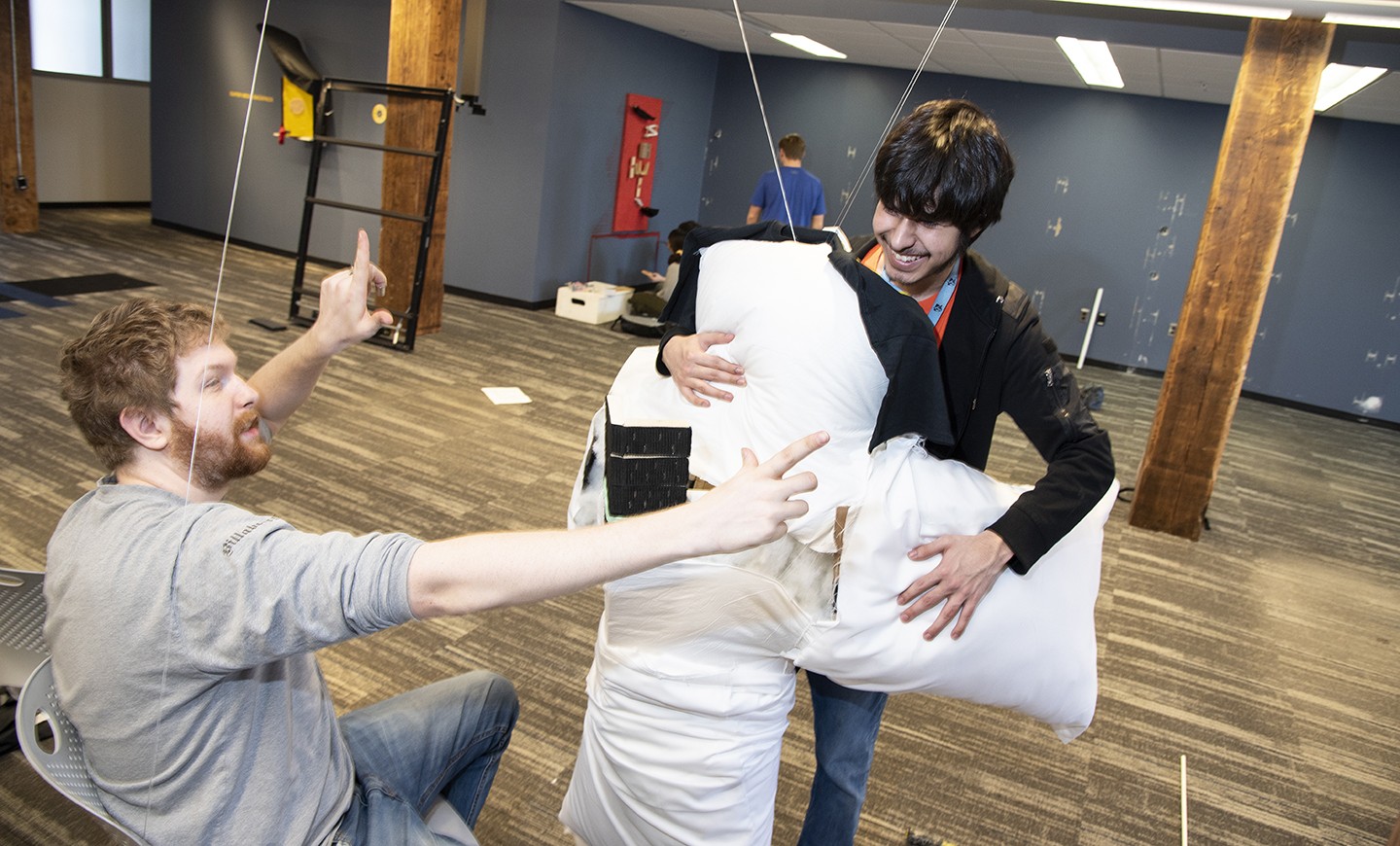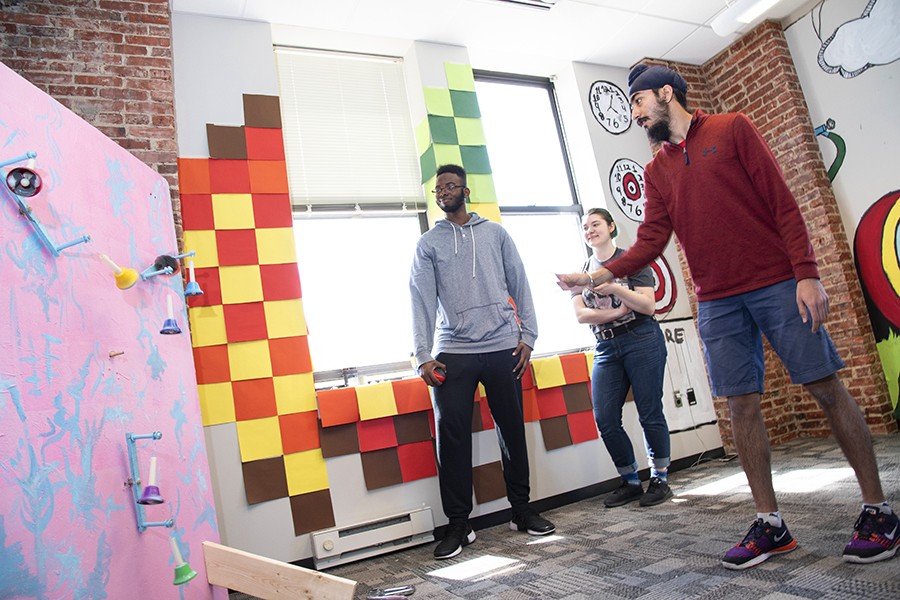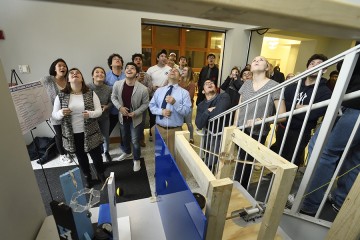When first-year students from Johns Hopkins University's Department of Mechanical Engineering first teamed up with students from the Maryland Institute College of Art on a semester-long design project, it seemed clear to the students how things would go.
"We'd bring the paint, and they'd bring the gears," said Emma Talpey, a first-year student from MICA.
But this assignment came with a twist: the 18 co-institutional teams, each made up of two MICA students and two or three Hopkins engineering students, were tasked with creating innovative and interactive "life hacks" based on their shared experiences. So while the Hopkins students brought engineering prowess and the MICA students brought aesthetic sensibility, the teams had to find common ground to create something new and unique that could also enhance their lives.
Last week, the student teams showcased these final creations in the exhibition "Hack Your Life Design Challenge," on the MICA campus.
Despite their different disciplines, students said they discovered common challenges when brainstorming project ideas. The one thing most first-year students can agree on? They have trouble waking up in the morning.
"We found that one big thing we all had in common was that we all valued sleep and don't like getting up for early classes. So we wanted to create something that would make it easier to get out of bed," said Talpey, who teamed up with fellow MICA student Yoon Jung Cho and Johns Hopkins students Annika Torp, Mark Shifman, and Edgar Camarillo.
Together, the team members created the "Rise N' Shine Machine," a multifaceted assembly that wakes its user in a matter of seconds. At the exhibition, visitors could walk into a fully furnished bedroom and try the machine themselves. With the push of a button, the lights turn on, the curtains rise, and the user's favorite music plays, making the daily "waking up" experience more efficient and enjoyable.

Image caption: “The Remedial Ripple,” a motorized art installation of gold blocks that reads “Peace begins with a smile.”
Image credit: Michael Ciesielski
The teams had a few basic requirements: they had to use at least five different materials, the project had to be interactive, it had to have moving parts, and each team had a budget cap of $100. Otherwise, students had the freedom to explore different ways in which engineering and art can intersect.
"We started planning this design challenge about a year ago," said Steven Marra, Johns Hopkins associate teaching professor of mechanical engineering, who taught the collaborative course along with Laure Drogoul, Edon Muhaxheri, and Jenna Frye—all MICA professors. "Teamwork and interdisciplinary collaboration are so important to success in any field, and this assignment really demonstrated that."
One takeaway from the project was that students had to learn how to speak each other's language – even as they approached the design challenge with very different skillsets.
"We had to figure out the best way to explain things to each other," said Alexander LeFevre, a first-year Hopkins mechanical engineering student. "We had to manage each other's expectations, and make sure everyone was doing their part."
LeFevre worked with classmate Lukas Sznewajs and MICA students Yeji Kim and Julianna Yu to create "The Remedial Ripple," a motorized art installation of gold blocks that reads "Peace begins with a smile." When turned on, the gold blocks reach their respective peaks at different times, creating the illusion of a wave or ripple.
"We figured out we weren't always on the same page with the MICA students," Sznewajs said. "But ultimately we were able to meet in the middle. They focused on the presentation, and we focused on getting the thing to work."

Image caption: Students create a hugging machine called Maxbay.
Image credit: Michael Ciesielski
Members of another team realized they all experienced homesickness and wanted to channel that feeling into something useful. MICA students Abbey Franklin and Spencer He, and Johns Hopkins students Theophile Garnier and Michaela O'Donnell, created a pair of mechanical flowers with petals that are programmed to open and close simultaneously, based on the user's emotional state. For example, a user can close the petals if they are having a bad day, allowing friends or family in distant locations to see how they are feeling.
According to O'Donnell, the project helped her understand that engineering and art often need to overlap.
"You can build a product that works great, but people aren't going to buy it if it doesn't look good, too," she said.
Other projects included a "smart" umbrella, a new take on the traditional backpack, a hugging machine, the "ultimate study space," a device that "eats" smartphones and provides conversation topics in return, a swing set that lights up when the users swing in sync, and a "sensitive monster" that approaches when spoken to gently but scurries away if things get too loud.
"This was probably the most challenging design project I have ever assigned for a few reasons: students were purposely given little direction in what to create, most of them had very little experience working with motors and mechanisms and microcontrollers, they had limited space in which to build and troubleshoot their projects, and the lack of shuttle or van service between the two campuses made getting to and from MICA very inconvenient," Marra said. "But somehow our amazing students pulled it off. And they created some truly impressive works."
The "Hack Your Life Design Challenge" exhibition will be up until Wednesday, May 2 at 81 Mosher St., second floor, on the MICA campus. Please contact Marra by email at marra@jhu.edu to schedule a viewing.
Posted in Arts+Culture, Science+Technology, Student Life
Tagged mechanical engineering










